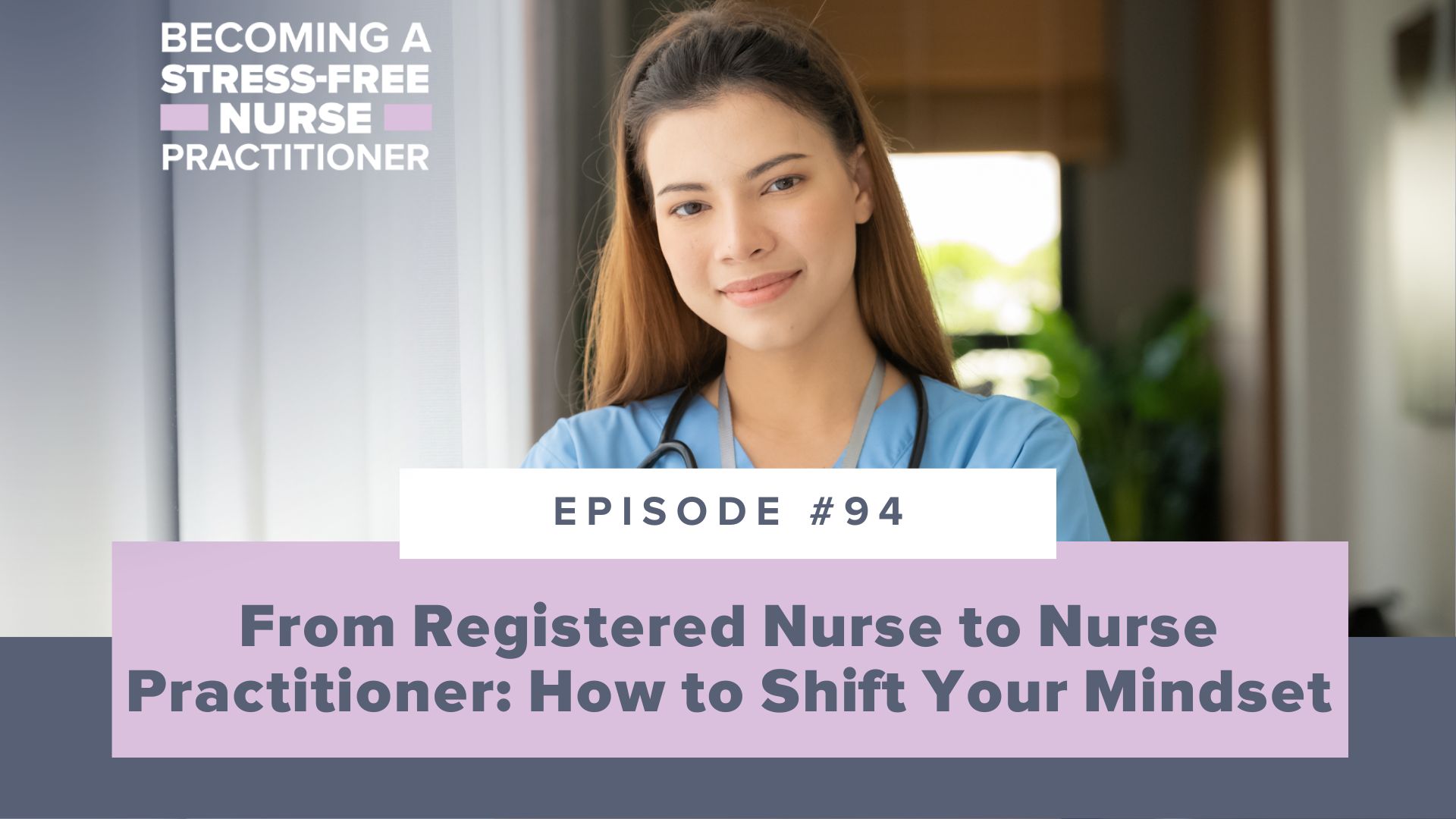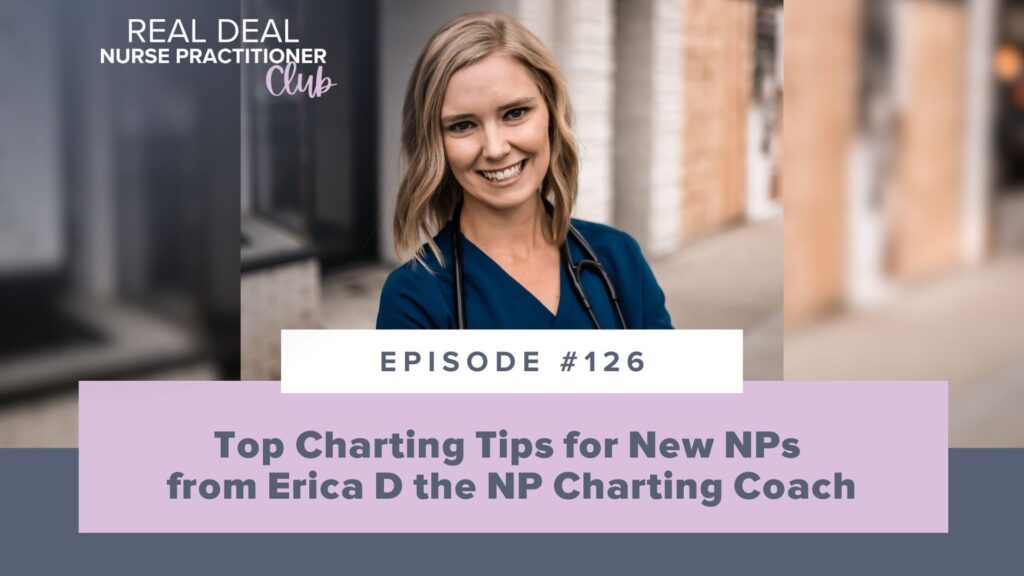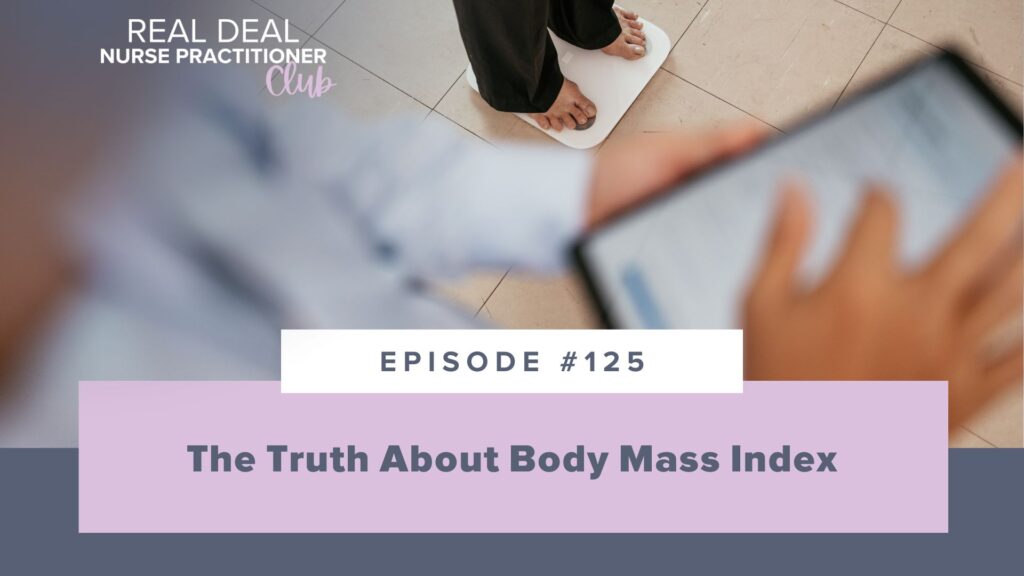Ep #94: From Registered Nurse to Nurse Practitioner: How to Shift Your Mindset
- by
- Aug 23, 2023
- Podcasts

Nursing is one of the few professions wherein you can transition from an expert to a novice literally overnight. Some students transition more easily into their roles as Nurse Practitioners, while others struggle with obstacles like role confusion and imposter syndrome, which can feel extremely stressful and intimidating.
That’s why, in this episode, I’m sharing my thoughts on making the leap from a registered nurse to a student Nurse Practitioner to a real-deal NP. You’re not alone if you’re having a tough time adjusting to the mentality of a Nurse Practitioner, and this week, I’m showing you how to make it a little easier.
Join me today as I offer my insights into shifting your mindset from the role of a nurse to that of a provider. You’ll hear why making this transition can often feel like navigating uncharted territory, the factors that influence how you perceive yourself as a real-deal Nurse Practitioner, and my top pieces of advice regarding clinical decision-making.
If you’re looking for support, no matter what phase of your nurse practitioner journey you’re currently in, I have communities available for both students and new nurse practitioners. In these communities, we work to uplift one another and grow this profession together every day, so click here to check them out!
What You Will Discover:
- The factors that influence how you think about yourself as a Nurse Practitioner.
- One of the biggest challenges new Nurse Practitioners face.
- How to start shifting your mindset from the role of a nurse to that of a provider.
Featured on the Show:
- If you’re looking for extra support, I have communities available for both students and new nurse practitioners. Click here if you’re a student, and click here if you’re a new NP!
- Follow me on: Facebook | Instagram | YouTube | TikTok
Full Episode Transcript:

Welcome to Becoming a Stress-Free Nurse Practitioner, a show for new NPs and students that want to pass their board exam the first time and make that transition from RN to NP as seamless as possible. I’m your host Sarah Michelle. Now, let’s dive into today’s episode.
Hello friends, Sarah Michelle here. In this podcast episode let’s talk about how to think like a nurse practitioner. So I’ve been thinking a lot about my own personal journey from novice nurse practitioner student to becoming a real deal, like so many of you are right now.
And nursing is one of the few professions where you can go from an expert to a novice in what feels like literally overnight. Some students adapt easily and fall smoothly into their role as a student nurse practitioner while I’ve seen others really struggle with things like role confusion, that’s a huge one, and imposter syndrome.
Change is hard, y’all. And it can be super stressful and super scary. And so today I’m just going to talk a little bit about making that leap from registered nurse to student nurse practitioner. And then changing your mindset to start thinking like a real deal NP.
And so what are some factors that influence how students adapt? Well one is, by far, experience. And I know it sounds crazy, but previous nursing experience can either be helpful or harmful.
And what I mean by that is I’ve seen nurse practitioner students with years and years and years of great nursing experience, but they have a really tough time adjusting their mentality to that of a nurse practitioner. They’re totally different roles, right?
And on the flip side, students can leverage that previous nursing knowledge, experience, and really, intuition to build their foundation as they develop into their new role as a nurse practitioner too. So we can really see both ends of the spectrum.
And one of the biggest challenges I see among new nurse practitioner students is navigating how to make clinical decisions and understanding the process of what it’s like to formulate a differential diagnosis. And as nurses this is uncharted territory because we know that diagnosis and treatment are outside the scope of practice of a registered nurse.
And therefore, as new nurse practitioner students this really requires a change in the way we approach our patients and work through that clinical decision making process.
And so let’s take a deep dive into what this process looks like and how we can begin to shift our mindset from the role of a nurse to that of the provider, because that’s what you will be. First of all, what is clinical decision making anyways? Well, it’s really a dynamic process that consists of three phases.
Number one, diagnosis. Number two, assessment of severity. And then number three, management. And friends, this is where experience comes into play again. Expert nurse practitioners can use their experience through knowledge of evidence-based practice and familiarity with their patients to begin to develop and narrow down a possible list of differential diagnosis.
And for students, you can lean on your previous nursing experiences along with all of the new and exciting knowledge that you’re learning in the classroom to help you start formulating diagnosis and treatment plans for your patients.
Now, I know this process can be confusing and overwhelming, especially when you’re new at it. But fortunately for us we have a whole bunch of tools in our toolbox that we can use to help guide us in the right direction. And I’m thinking about things like taking a thorough history, completing an accurate physical exam and using that information to determine any diagnostic test we might need to order.
And so you might be asking yourself, well where in the world do I even start? And the first step in thinking like a real deal nurse practitioner starts with the patient’s chief complaint or their reason for coming to see you in the first place. Based on this information we can begin to gather a detailed and focused history that ultimately will help us start building that differential diagnosis list.
There are a couple of history taking tips that I always love to share with students. And the first one is simple but so important, be organized. Just like with your physical exam, use a systematic approach. And over time by using a systematic approach, you’ll find that taking a good history is almost second nature.
By no means do I mean that you should interrogate your patients with a long list of questions. History taking should ideally be a little bit conversational. But if you ask the same questions over and over in relatively the same manner, you’re less likely to forget important questions that can lead you to vital information.
Second, be a good detective and ask the right questions, even if sometimes it feels a little uncomfortable. For example, a patient presenting with a diffuse rash on the hands and the feet we should ask about sexual history, because secondary syphilis should definitely be in our list of possible differentials. Also, too, pay attention to your patients’ verbal and nonverbal cues. You can glean a lot of information, just from picking up on those subtle cues.
Now that you’ve taken a good history, let’s pause for a second and talk about those physical exam findings. Think back to your assessment course and how to differentiate between what is normal and what is abnormal. Also, consider if those findings are even relevant to the patient’s chief complaint.
For instance, a patient comes in with a two day history of cough and congestion. And during your physical exam you notice a dry and flaky skin lesion on their face. While the skin lesion may be significant, it’s probably not related to their cough and congestion, right?
And on the other hand, what if we had heard expiratory wheezes during our exam? This is an example of clustering signs and symptoms. And friends, this is really going to help you out as you begin thinking about the next steps in your clinical decision making process.
To recap, we’ve taken our patient’s health history and we have our physical exam findings. And at this point, we need to start mentally developing our differential diagnosis list and thinking about what test, if any, we need to confirm or rule out a specific diagnosing.
Keeping with our wheezing patient with cough and congestion, what diagnostic tests do you want to order? Well, we need more information, right? How does the patient look? What are their vital signs? Do they have any comorbidities that put them at risk for complications?
So diagnostic testing should be guided by our history and physical exam findings. And there are a couple of reasons we may need to order additional testing. First of all, what if the patient’s diagnosis remains uncertain? Maybe they need a CAT scan or an x-ray for confirmation.
Diagnostic tests can also help establish the severity of a disease such as COPD or congestive heart failure and help rule out other conditions. A few words of wisdom here for me to you while we’re talking about diagnostic testing, please be mindful of cost effectiveness, patient safety and the invasiveness of the tests that you order.
Also, be sure to avoid the shotgun approach of fishing for diagnoses. With this approach, providers cast a wide net and order a whole bunch of diagnostic tests with hopes of catching a diagnosis. But that’s not cost effective and that can be harmful to our patients.
And last but not least, the biggest piece of advice I can give you when it comes to ordering diagnostic tests is never ever order a test if it’s not going to change your plan of care.
A common example that comes to mind is a pediatric patient with a fever. The patient is well appearing, runs around the exam room and they have a positive rapid strep test, and I see many new nurse practitioner students who are tempted to order that complete blood count or CBC because the patient has a fever.
But do we really need that white blood cell count? Is that going to change how we treat this patient? Unless our patient is toxic appearing or we’re concerned that maybe there’s something else going on here, this child is still going to go home with oral antibiotics, right?
The last piece of the puzzle we have left to talk about is the diagnostic process itself. We’ve collected all this data from our history, our physical exam findings and maybe some diagnostic test results, and now what do we do with it all?
Well, we can combine these findings to start looking for patterns. And this is going to help us further develop and refine our differential diagnosis lists, as well as assess the probability of conditions remaining on our list. And so at this point, we’ve probably narrowed down our list to just a few possible diagnoses. But what if there’s still some uncertainty?
Well, we have another tool in our back pocket we can pull out to help guide us, and that is our evidence-based resources. What I mean by that is our clinical practice guidelines, our treatment algorithms, our decision making tools like JNCA or the Ottawa ankle rules or the heart score. And friends, as nurse practitioner students, you aren’t expected to know everything.
And even seasoned nurse practitioners don’t know everything. And so my advice to you is to start building a library of resources now while you’re still in school. I personally use an old school address book to write down little clinical pearls and tips I learned for my preceptors and instructors and I collected different tables and treatment algorithms I found helpful.
So when I did finally become the real deal, I had all of these resources already at my fingertips. I was already comfortable with them. But, however, these tools are not without limits. And while they can be super helpful, they should never ever supersede your clinical judgment and individualizing your patient’s care.
Always trust your gut and do what you feel is best for your patient. But what if, at the end of the day after collecting all this data, exhausting our resources, we still don’t have a definitive diagnosis? What are we going to do now?
Well, we have a couple of options. We could order more tests. We could refer the patient for a consult with a specialist or we could have the patient follow up in our office. Whichever you choose, be sure to include a follow-up plan with explicit instructions and reasons to return or go to the emergency department. Misdiagnosis and delayed diagnoses are some of the most common causes in malpractice complaints.
And so before we wrap this one up, I have a couple of clinical decision making pearls I want to share with you all. Always consider life threatening conditions first. We definitely want to monitor for those red flags and rule those out, top priority.
Secondly, while it’s definitely important for us to be suspicious of less common diagnoses, remember that as a rule of thumb common diseases occur commonly. You’ve heard us talk about zebra questions on this podcast, well, beware of those zebra diagnoses in practice, too.
And what are some pitfalls? Well, circling back to experience, we know that as nurses we tend to compare our patients to previous experience, right? And while this can absolutely be beneficial, it can also lead to us jumping to conclusions and making assumptions.
For example, I see a patient with a history of three COPD exacerbations requiring hospitalization in the last year. He presents to the clinic with worsening dyspnea exertion and we automatically assume that he’s having another exacerbation of his COPD without considering alternative diagnoses.
So another pitfall that we need to avoid is our own biases. We need to practice awareness and avoid biases in our clinical decision making always.
And last, but certainly not least, I’ll leave you with a word of caution. As a new nurse practitioner student, please don’t get so caught up in going down a rabbit hole chasing zebras or ordering a bunch of diagnostic tests that you ignore the basics, like assessment findings such as vital signs.
And that’s it for this week’s episode, my friends. We’ve walked through the steps of thinking like a real deal nurse practitioner and you’re on this beautiful and exciting journey from novice nurse practitioner student to real deal NP. And don’t forget to take some time to care for yourself as well. Get outside, enjoy what is left of summer, it is dwindling down. And I’ll be talking to you all in a couple weeks for another episode. But until then.
As an extra bonus, friends, if you’re looking for support no matter what phase of your nurse practitioner journey you’re currently in, I have communities available for both students and new nurse practitioners. In these communities, we work to uplift one another and grow this profession together every single day. Links to join will be included for you in the show notes.
Thanks for listening to Becoming a Stress-Free Nurse Practitioner. If you want more information about the different types of support we offer to students and new NPs, visit https://www.npreviews.com/resources. See you next week.
Enjoy the Show?
- Don’t miss an episode: follow the podcast on Spotify, Apple Podcasts, Google Podcasts, or RSS.
- Leave a review in Apple Podcasts.
Search the Blog
Join our Facebook Group!
Get FREE support and encouragement from thousands of FNP/AGPCNP students and our NP Support team.
Learn More3 Study Hacks to Conquer Your NP Exam!
Download these tips that have helped thousands of students pass their NP board exams.
Download NowInstitutional Partnerships
Are you a faculty member and would like to bring Sarah Michelle’s resources to your school? Email us at nursinggroups@blueprintprep.com for special institutional pricing or click on the link below to learn more.
Learn MoreGroup Discounts
Are you a student and have 10 or more classmates interested in purchasing Sarah Michelle’s courses? Email us at nursinggroups@blueprintprep.com for special pricing.



